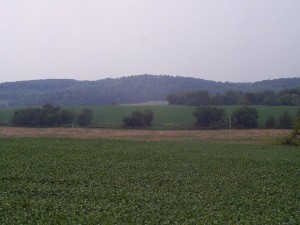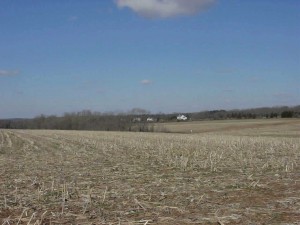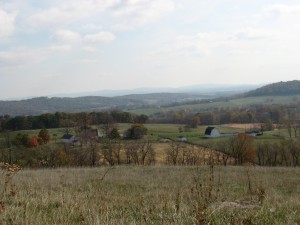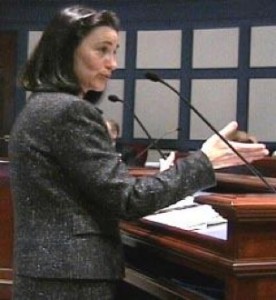Survey shows 1.4 million acres preserved by top state programs; $4 billion spent over 30 years
BY DEBORAH BOWERS, Editor & Publisher
2012 Farmland Preservation Program Costs[PDF]
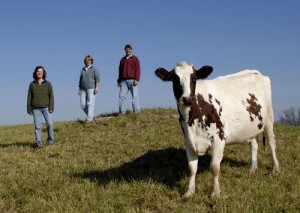
- Vermont programs preserve the land and help new farms get started, or add new product lines; this dairy farm added cheese making. (Photo by Bob Eddy for VT Housing & Conservation Bd)
The nation’s leading state-operated farmland preservation programs have preserved more than 1.4 million acres and 11,530 farms at a cost of about $4 billion since these programs first began operating in the early 1980s, according to a survey conducted by FPR. The survey, conducted in Aug. and Sept. 2012, looked at states in New England and the Mid-Atlantic, including Ohio, which purchase development rights from willing farm owners, and retire those rights in an effort to preserve local agriculture and open space.
Maryland and Massachusetts were the first states to develop programs, both enacting legislation in 1977 that established purchase of development rights as a government function. The protection of farmland became a mission and goal of the state in the absence of effective or adequately protective zoning at the local level. Programs are voluntary and pay farmers in per-acre amounts that represent the difference between the appraised fair market value of their land, and the value of that land for agriculture. Protection is in the form of a deed of conservation easement that runs with the land in perpetuity. Land remains in private hands and on tax rolls.
Farmland loss due to sprawl was first noted as a local problem on Long Island, NY, in the 1960s and a program to purchase easements was developed there in 1974 in Suffolk County in an effort to save its remaining agricultural industry. At extraordinary cost, the county has preserved about 6,000 acres.
After Maryland and Massachusetts adopted the conservation easement as the method for preserving agricultural land, other states followed suit, many adopting many aspects of the Maryland or Massachusetts laws. Those included all states along the Eastern seaboard from Maine to Virginia, and to other states such as Ohio, Kentucky and Michigan. The survey includes only those states with programs that are active, funded and comparable in operation to Maryland’s. The survey excludes programs in the West in such states as California and Colorado.
Following are summaries, with links, of the state farmland programs included in the survey.
Connecticut
The Connecticut program has preserved 38,600 acres and 283 farms. In 2010, the state preserved 15 farms and 1,228 acres for $5.6 million, according to the program’s annual report. After a period of virtually no funding due to a reluctant bond commission, for a number of years now the Connecticut farmland preservation program has been budgeted to receive $10 million in bond funds as well as about $1 million from a statewide recordation fee that in 2010 alone paid for preserving six farms.
While it is the third smallest state in the U.S., Connecticut’s agricultural industry, according to a 2010 UConn study, has an economic impact of $3.5 billion when including its $1.7 billion “value added” segment. The study may have given some steam to a new program, connected to the farmland preservation program and inaugurated in 2011 – the Farmland Restoration Program. This program was created to spur local food production with grants of up to $20,000 for such projects as restoring overgrown or unused pastures and cropland to productive use, including removal of invasive vegetation and hedgerow management. Installation of fencing – for keeping livestock or for excluding wildlife – and restoring stream banks are also eligible projects. Grant funds are in the form of reimbursement for approved costs.
The Connecticut program has set a goal of preserving 130,000 acres, as long as at least 85,000 of those acres are cropland. The program states on its website: “This land base will enable Connecticut to produce at least 50% of its fluid milk needs and 70% of its in-season fresh fruits and vegetables. This in-state production will ensure some degree of local availability of fresh farm products. It will also help ensure related jobs and remain an important part of the State’s economy.”
Farmland makes up about 13 percent of the state’s land mass, and its 4,916 farms (average size of 82 acres) rank first in New England in terms of market value per farm and per acre, according to the UConn study. The program is administered by veteran director Jay Dippel.
Maryland
The Maryland Agricultural Land Preservation Foundation (MALPF) has preserved, since 1980 when the first easement was purchased, 279,223 acres on 2,043 farms. The MALPF program is governed by a 13-member board of trustees that oversees grants to counties, but not all counties are equal. Those that gain certificationaccording to state guidelines are authorized to retain 75 percent of the state agricultural conversion tax collected within their boundaries to use for farmland preservation, using their own program or partnering with the state program. Those that are not certified retain 33 percent.
But these revenues may or may not be enough to support a county’s preservation agenda without the state’s matching funds, and that has been anything but certain in its recent history. While some counties in a given year have more money allocated to farmland preservation than the entire state fund, others have zero preservation dollars.
The state program’s funding has been hard hit by a legislature and successive governors who see its supposedly dedicated real estate transfer tax revenue stream as a way to help prop up Maryland’s continually ailing, though Triple-A rated, fiscal condition. Since about 2003 the program has been robbed of its purse strings, leaving its money available for the taking for the state’s general fund, including, at times, funds that were allocated but not yet spent. The MALPF staff of seven often struggles to keep up with policy and legislative changes and funding adjustments, as well as overseeing the monitoring and enforcement of its more than 2,000 easements. The program has a strained relationship with some of its county-level program partners due to changes in policy and regulations and often the interpretation of these by legal counsel. Landowners and even their attorneys are often confused by program policies, particularly policy regulating subdivision.
Some counties have benefitted from local leadership more than others. Carroll County, which ranks 4th in the nation for number of acres preserved (62,000+) was out in front early in the program, and has long had the largest percentage of acres preserved under MALPF, at nearly 15 percent. Carroll is followed by Caroline County, on the Eastern Shore, with 11 percent, although Caroline does not have a certified local program. The next highest percent is Baltimore County, which is certified, at almost 8 percent.
Massachusetts
When the Massachusetts legislature created a farmland preservation program in 1977 it called it the Agricultural Preservation Restriction (APR) Program. Along with Maryland, it is the oldest state farmland preservation program, but has preserved just 80,000 acres to date, and 800 farms. But with a New England climate, agriculture is something to be coddled, and preservation eligibility criteria seem to reflect this – an owner needs just five acres to apply for easement sale, compared to 50 acres in Maryland (formerly 100 acres). The Massachusetts program also reflects a tenacity to hold on to agriculture and to help the industry succeed on its own terms. For example, the Farm Viability Enhancement Program that was launched in 1996 focuses on boosting farm profitability with technical assistance and business planning and grants for investing in equipment or infrastructure, and then pays for term easements, called covenants, of from five to 10 years, with payments ranging from $50,000 to $100,000 for varying production levels. Since its inception the program has awarded grants, with covenants, to 337 farms. Grants pay for such improvements as new or enlarged farm produce stands, dairy barns or processing plants, new or used equipment or sheds.
The cost of permanently protecting land from development in Massachusetts is rivaled only by New Jersey, at an average cost in 2011 of $11,487 per acre.
New Jersey
After nearly 30 years of funding the purchase of development rights through real estate boom and bust years, preserved farmland in the nation’s most densely populated state is reaching the notable milestone of 200,000 acres preserved.
Farmland preservation in New Jersey has always been funded through bond issue, and voters have consistently supported farmland and open space preservation at both the state and local level, either through bonds or open space taxes, the last in 2009. Gov. Chris Christie put off appropriating the borrowed funds that voters approved, but eventually did sign bills that released the funds. Last year he signed appropriation bills that secured $90.6 million for farmland preservation acquisition projects for both state and local-level acquisition. State-level acquisitions by the State Agriculture Development Committee (SADC) have $19.7 million allocated and there is $39 million for grants to 16 participating counties to preserve farmland, consisting of a $1.5 million dollar “base grant” to each county and a $15 million competitive grant fund. Counties use their base grants and then compete for additional grant funds until the money is exhausted. Any county can qualify for up to $3 million in competitive grants, for a potential total maximum combined grant of $4.5 million. In addition to the county level funding, $23 million is available in grants to participating municipalities. Last but not least, $8.8 million is available in grants to eight nonprofits that preserve farmland this year, the largest fund yet made for land trusts by SADC. The SADC program and its 30-plus employees are led by Susan Payne, executive director since 2005, whose prior experience leading the Burlington County program put her in a good position to build optimum working relationships with county programs. The SADC operates a number of programs in addition to farmland preservation that aid agriculture in the state.
One of SADC’s programs that is unique among state farmland preservation programs is its emergency fee simple option for farms that must be sold. SADC buys the farm, places the deed restriction on it, and resells, at auction, to a bonafide farmer.
SADC has been involved in a number of cooperative projects over the years involving multiple agencies, including a large project concluded in August on the 1,900-acre former Princeton Nurseries property in the center of the state. The $28 million agreement used more than $16.5 million in state, local and nonprofit open space funding for the fee purchase of 512 acres to become a state Wildlife Management Area and nearly 500 acres as additions to the Monmouth and Mercer County park systems. The SADC and its county and local partners provided another $11.4 million to purchase farmland easements on an additional 847 acres.
New York
New York’s farmland protection program has two funding channels– one to local planning for farmland protection and the other to implementing those plans. Planning grants are available for counties to cover up to 50 percent of the costs to develop agricultural and farmland protection plans. Several grants of up to $50,000 each are awarded on a rolling basis each year to counties that apply. The program has awarded over $2 million in planning grants to 48 counties. For purchase of development rights, the program has awarded nearly $80 million to protect approximately 36,000 acres on 200 farms in 18 counties, according to the program website.
The program over its history has had difficulty getting localities to complete projects once approved. A 2010 comptroller report found that no funds appropriated over the prior two budget cycles had been encumbered and that only half of the funds appropriated in 2008-09 had been encumbered.
According to Farmland Protection Program manager David Behm of the NY Dept. of Agriculture and Markets, as of Nov. 2012, 22 localities with awards amounting to $19.4 million, have not provided necessary documents, such as title commitment, deed of easement, and monitoring plan, to close on projects. They have until mid-January 2013 to do so, he said, or funding may be withdrawn.
Unlike other programs, the State of New York is not a grantee on a deed of easement under its program, and retains no interest in the property. Therefore, the program has no stewardship or monitoring role.
Ohio
Ohio has preserved, in its first 10 years, 311 farms, comprising more than 54,143 acres, almost 12 percent of those acres through easement donation. The Ohio program controls costs by paying up to 75 percent of a points-based appraised value of a farm’s development rights. A payment cap is set at $2,000 per acre, with a maximum of $500,000 per farm.
The Agricultural Easement Purchase Program (AEPP) is the farmland preservation component of the Clean Ohio Fund bond initiative, which was originally approved by Ohio’s voters in 2000, who gave a thumbs up to continue the program with another bond issue in 2008. However, as in other states, no grant funds were appropriated from bonds for FY 12, but a one-time allotment of FRPP program funds was allocated, and in 2011, 38 easements were closed, preserving 6,470 acres in 19 counties.
To further encourage easement donation, last year the program added the Agricultural Easement Donation Partnership Program, which reimburses local partners (counties, townships, Soil and Water Conservation Districts, or land trusts) for real estate closing and administrative costs when receiving donations under the state’s farmland preservation program. The department has set aside $50,000 to cover up to $3,000 in costs for the donation of farms up to 200 acres. The incentive would increase by $5 per acre for easements on farms of more than 200 acres. Funds will be equally available in all areas of the state.
Pennsylvania
The Pennsylvania farmland preservation program was launched a full 10 years after Maryland’s, but about five years ago its tally of preserved acres overtook the Maryland tally due to a steady and truly dedicated funding stream (save this year’s attempt by Gov. Tom Corbett to divert those funds). In the not too distant future the program will reach the half-million acres milestone.
The program is administered by the Pa. Dept. of Agriculture’s Bureau of Farmland Preservation and is funded through a flat appropriation of $20.5 million per year from the cigarette tax in addition to funds from a bond fund that in 2011 provided $5.11 million. Total funding in 2011 was $36 million, including federal, state, county and local dollars. Of the 57 counties eligible to participate in the program, 53 appropriated $16.5 million in local matching funds for the 2011 calendar year.
Some Pennsylvania counties operate independent programs but most need state direction and oversight. Lancaster County is the state’s most noted local program and ranks as the No. 1 local program in the nation, with more than 90,000 acres preserved, including those preserved through a cooperative agreement with the nonprofit Lancaster Farmland Trust.
The most active county programs, not surprisingly, are in the southeastern quadrant of the state, where development pressure comes from the Philadelphia region, Maryland and New Jersey.
Like Maryland, the Pennsylvania program recently erased from its law the possibility for preserved-farm owners, after 25 years, of buying back their easement by claiming their land can no longer be farmed. The change, however, does not affect the easements purchased prior to the law. Maryland has recently received two such claims, and the Pennsylvania program will reach its 25-year anniversary in 2014.
Vermont
Vermont combines the private nonprofit sector with its state operated land preservation program like no other state, funding land preservation through its Housing and Conservation Board (VHCB) and working with the Vermont Land Trust (VLT) to carry out the easement process. To date, Vermont has preserved 170,000 acres, the most by far of any New England state, and at a cost of just $1,520 per acre average. Vermont’s Farmland Conservation Program in its most recent round combined agricultural preservation with riverbank conservation, making a number of easement purchases on farms with a combined 8,000-plus feet of river frontage. In May 2012 the VHCB, which oversees the program, committed $1.48 million in state allocated funds to match a federal Farm and Ranchland Protection Program grant of $1.92 million. This was enough to complete conservation easements on 13 farms and 2,112 acres. The farmland preservation program is supplemented by a Farm Viability Program that provides grants for entrepreneurial projects or farm operation upgrades, for example, helping a dairy with equipment purchases or building renovation to add a cheese making facility. VLT has preserved 2,100 acres and 21 farms in addition to the state tally.
Virginia
The Virginia Farmland Preservation Programhas preserved 5,525 acres and 41 farms since enactment in 2000, a notable minor contribution to the state’s broader land preservation effort to receive easement donations in exchange for ample
state tax credits. That effort, carried out mainly by the Virginia Outdoors Foundation, has resulted in about 900,000 acres of open space and farmland preserved via donated easements, about two-thirds being held by VOF.
Virginia was late in adopting PDR for farms and farmers who had little to benefit from income tax credits and has spent little on it compared to other states –$12.3 million to date.
Twenty-two local PDR programs exist in Virginia, 18 of which have had some level of local funding available over the past few years. Shenandoah and Washington Counties are receiving state matching funds for the first time. This year is only the fifth time the state has provided matching funds for local PDR programs. A total of $6.45 million has been allocated since Feb. 2008.
West Virginia
West Virginia’s program was enacted in 2000 and farms are preserved by a state authority as well as by local Agricultural Protection Boards. Local boards were authorized to levy real estate transfer taxes to support their farmland efforts, and this has kept the protection effort steady if not growing notably. In the 10 years since the West Virginia Agricultural Land Protection Authority was established, and county boards continued to be formed, the state and local efforts combined have preserved 17,129 acres and 141 farms, many of those in the state’s Panhandle region.
Remembering Mary Heinricht
Mary Heinricht, a longtime advocate for farmland preservation and a driving force behind the establishment of several programs, died in April following complications with colon cancer. The New York native was 62.
She had recently returned to Virginia Beach to continue her grassroots efforts there, looking out for the interests of land itself and the people who work it. She is remembered in Virginia Beach for being instrumental in creating that city’s farmland preservation program, enacted in 1995. At the time of her death she was developing a new nonprofit to focus on regional land use issues.
I reported on Mary Heinricht’s work over the last 20 or so years, and her multiple efforts can be recounted in the pages of FPR’s archives, but she was also a friend of mine. Although our relationship was built around our professional life in the world of farmland preservation, we were also kindred spirits and I saw her as a “comrade at arms” in the long war against development of farmland and the governmental neglect of agriculture in urbanizing regions. I remember Mary not only for her leadership in creating Virginia’s first, and still its most innovative, local farmland preservation program, but also for her courage in moving about the country and planting her knowledge and persuasive powers wherever she felt she could make the case for farmland preservation and farmers holding on to their land in the ever widening suburbs.
I last heard from Mary in June 2012. She said she was putting together a regional environmental effort focusing on sustainability and had a number of business interests who had signed on to support her work. “We’re going to try and tackle the codes…” she said and I knew the minutia she was about to engage in. The Hampton Roads Chamber of Commerce was on board with her ideas and operation plan. I told her “go, girl.”
Mary’s work in Virginia Beach began as coordinator of an ad hoc committee that promoted adoption of the Virginia Beach purchase of development rights program that used the installment purchase method of buying conservation easements. Mary and the committee she led were able to demonstrate that sprawl was wreaking havoc on the municipal budget and that farmland preservation was key to stabilizing the economic outlook for the city. That alone was a remarkable achievement. But wait, there was more. The City Council voted for a tax increase to support the program, and it raised between $3 and $4 million annually. This new program had air to breathe.
The saving grace for the city was that there were still about 34,000 acres of farmland within the city limits, and just as important, these lands were still owned by farm families. Mary said the timing for the program was optimum politically and economically, and she was on the mark when she predicted success. To date, the program has preserved 9,100 acres.
Mary’s education was in landscape architecture and regional planning from the Rhode Island School of Design. She had worked in real estate development and management in New York. This all made her a valuable addition to farmland preservation efforts. In 1998, after Mary’s success in Virginia Beach, the American Farmland Trust (AFT) hired her to serve as its Mid-Atlantic Regional Director, and she soon shared that office with Allison Deets, now Allison Aurand, who became a close friend.
Mary’s employment with AFT enabled her to continue building grassroots support for a statewide farmland program in a state that was unfamiliar with the subject. She and Allison worked magic on legislators and the public, and the Virginia legislature unanimously adopted a PDR program as a budget amendment in 2000, and again as a full-fledged program in 2001.
Mary and Allison together developed the catch phrase “It’s Not Farmland Without Farmers”© as they tried to develop a farmland preservation program that extended the preservation mission to assisting farmers with transition planning and business development. I remember conversations with Mary about the importance of extending preservation dollars into transition and estate planning and getting local and state economic development folks to understand that agriculture was the industry most deserving of assistance and tax breaks. Unlike other industrial enterprises, agriculture possesses a unique kind of staying power, a kind of wealth built around family, pride, and love for the land.
Jeffrey Everett of the New Jersey State Agriculture Development Committee, and formerly with the Valley Conservation Council said it was apparent to him while in Virginia, his native state, that Mary was the force behind the creation of the Virginia program.
“Mary’s tenacity and commitment to the cause of farmland preservation ultimately resulted in the creation of the Agricultural Vitality Program,” he said. “That was a gift that all Virginians should be grateful to her for,” he said.
Today however, Everett has pointed out, Virginia’s farmland program is heavily overshadowed by a tax credit for easement donation that sideswipes the mission of farmland preservation by favoring those landowners who can reap the benefits of a break on state income tax.
Allison Deets later returned to her native Bellingham, Washington, where she managed the Skagit County PDR program and Mary, a year or two later, drove across the country and stayed for several years in the area. She found work advocating for farm groups and others as the mission of farmland preservation did battle with that state’s wetland loss mitigation program. Bulldozing good agricultural land and calling it habitat restoration didn’t make sense for the environment or for agriculture, Mary stated, as I covered the issue for FPR in 2007.
Allison worked with Mary Heinricht for more than 10 years and it was quite a ride, as Allison tells it. Mary had strong opinions “and a temper” Allison said, remembering a time when Mary got mad at a tech guy and Mary took her for a “forced march” through the streets of Washington for three hours, until Mary settled down. But Mary’s other qualities made the friendship lasting.
“She was challenging to work for, but she had a gift for bringing people and disparate interests together. She bridged gaps and made uncommon partnerships work. She had a savvy about people and organizations.” In other words, she knew when things were not what they appeared to be.
Mary’s ability to talk and work with farmers brought about lasting achievements, Allison said, and with that I can agree. It seems a simple thing, but in farmland preservation efforts today, there is a great need for understanding and empathy with the landowners whose land we seek to protect.
“Farmers loved her. She said what she thought. She appealed to them in a way that I’ve never seen any other non-farmer do.”
Mary, for those you have left behind, we will continue to try to keep things moving. We will miss you sorely.
